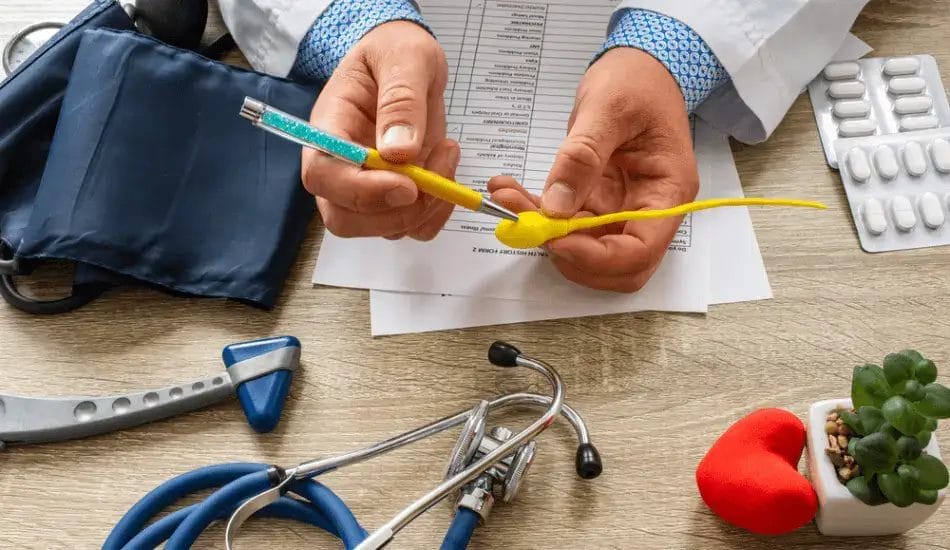Getting a vasectomy reversal is an important decision when it comes to your fertility. Whether you’re looking to expand your family or are experiencing a change in life circumstances, understanding the surgery is essential to making an informed decision. At Men’s Health Clinic Manitoba, we are knowledgeable about vasectomy reversals and strive to help you achieve your fertility goals. Let’s review the information you need to know about reversing a vasectomy.
What Is Vasectomy Reversal?
A vasectomy reversal is a surgery that restores fertility in men who have undergone vasectomies. What does the surgery entail? We have the answers below.
- The Goal: The goal of a vasectomy reversal is to restore the flow of sperm from the testicles to the urethra. The process is meant to restore the possibility of conception during sexual intercourse.
- The Vas Deferens: The vas deferens are a pair of tubes responsible for transporting sperm. During a vasectomy, these tubes are cut, sealed, or blocked to stop sperm from entering the ejaculated semen.
- Reconnecting the Vas Deferens: During a vasectomy reversal, the doctor will carefully reconnect the severed ends of the vas deferens. It brings back the pathway for sperm to travel through.
- Restoring Fertility: Once the vas deferens are reconnected, the sperm can mix with semen during ejaculation, bringing you one step closer to your family planning goals.

What Factors Should You Consider Before Getting a Vasectomy Reversal Procedure?
Before deciding on getting a vasectomy reversal, there are many factors to consider. Here’s the information men should know before getting their vasectomies reversed.
- Timing Is Key: How long it’s been since your original vasectomy can impact the success rate of getting it reversed. The sooner you get the vasectomy reversal, the more likely the surgery will be successful. However, you should always consult with your doctor to determine the best timing for your vasectomy reversal, especially if you’re concerned about conditions like Azoospermia affecting fertility.
- Family Planning Goals: Think about your family planning goals before deciding to get this surgery. There is potential for alternative options. Always be sure before you choose fertility restoration.
- The Cost Factor: Vasectomy reversal is a surgical procedure that may involves expenses. Discussing the financial aspects with your healthcare provider and exploring whether your insurance covers the procedure is essential.
- Alternative Contraception Methods: If vasectomy reversal is not an option or is unsuccessful, familiarize yourself with alternative methods for achieving pregnancy. Assisted reproductive techniques, such as in vitro fertilization (IVF) or sperm retrieval procedures, may be viable alternatives. Exploring options like sperm retrieval can provide additional paths to fatherhood.
- Consult With Professionals: Before deciding on vasectomy reversal, consult healthcare professionals, including urologists or reproductive specialists. They can provide expert guidance, answer your questions, and assess your suitability for vasectomy reversal.

How Does Vasectomy Reversal Work?
Understanding the vasectomy reversal procedure is vital for individuals considering this path to restore fertility. Here, we’ll provide an overview of the steps and techniques involved in vasectomy reversal:
- Anaesthesia: Unlike with the original vasectomy, a vasectomy reversal is more complex. You will require sedation for the procedure to ensure you are comfortable.
- Accessing the Vas Deferens: Next, the doctor will proceed to access the vas deferens, which are the small tubes that transport sperm from the testicles to the urethra.
- Careful Reconnection: The main part of vasectomy reversal is the reconnection of sperm flow. Depending on level of obstruction, we will decide whether we proceed with a direct connection (vasovasostomy) or bypass connection (vasoepididymostomy).
- Checking for Patency: After reconnecting the vas deferens, your doctor will check that the area is unobstructed, called patency, to ensure the sperm can flow freely through the vas deferens. It’s an important part of determining the success of the procedure. This will occur 2-3 months after the procedure. It can take up to 6 months for sperm to return to the ejaculate after a vasovasostomy or 12 months after a vasoepididymostomy. For those considering a vasectomy in Winnipeg, understanding these timelines is crucial.
- Closure: Depending on the technique used, the tiny openings to access the vas deferens are closed with dissolvable stitches or adhesive strips. The scrotal area is then dressed, and you’ll be on your way to recovery.
- Duration of the Procedure: A vasectomy reversal procedure takes 2-3 hours to complete. However, the duration can vary depending on the techniques used and the patient’s needs.
- Recovery: Following surgery, you should follow your doctor’s post-operative care instructions. The process may include rest, pain management, and follow-up appointments to confirm fertility.

Vasectomy Reversal Success Rates and Expectations
It’s important to understand the success rates and how to manage your expectations when considering vasectomy reversal. These are some considerations to think about before getting surgery.
- Success Rates: Vasectomy reversal is generally considered a highly successful procedure, especially when performed by experienced surgeons. The success rates can vary. Factors influencing success include the surgeon’s skill, the time since the vasectomy, and individual factors. In our experience after a vasovasostomy (direct connection), success rates can range from 90-95%. Following a vasoepididymostomy (bypass connection), success rate can range from 60-65%.
- Post-Reversal Pregnancy: After a successful vasectomy reversal, it may take several months for fertility to return fully. Patience and being realistic about the timeline for achieving pregnancy are essential. For some, it can occur within a year, while it may take longer for others.
- Potential Outcomes: While vasectomy reversal offers the possibility of natural conception, not all cases result in pregnancy. Factors like the female partner’s fertility, sperm antibodies, or other medical conditions can affect the outcome.
- Follow-Up Semen Analysis: A follow-up semen analysis determines if the surgery was successful. This test assesses the presence and quality of sperm in ejaculated semen. It may take several months post-reversal for sperm count and motility to return to optimal levels. While waiting, address any other related health concerns, such as erectile dysfunction, to ensure overall reproductive health.
Managing expectations and understanding that success rates can vary will help you approach vasectomy reversal with realistic hopes. The surgery has a high possibility of restoring fertility, but it may take time to come into effect.
Alternatives to Vasectomy Reversal
There are other options besides restoring fertility. Before deciding on a vasectomy reversal, consult with your doctor to determine the best option for you. Here are alternatives that also work for men.
In Vitro Fertilization (IVF): IVF is a widely used assisted reproductive technique that can bypass the need for vasectomy reversal. It involves fertilizing eggs outside the body and transferring the resulting embryos into the female partner’s uterus. IVF can be an excellent choice for couples facing fertility challenges.
Sperm Retrieval Procedures: When vasectomy reversal is not an option or has failed, sperm retrieval procedures may be considered. These techniques, such as testicular sperm extraction (TESE) or epididymal sperm aspiration (TESA), involve obtaining sperm directly from the testicles or epididymis for use in IVF.
Adoption: For couples unable to achieve pregnancy through biological means, adoption is a meaningful option to consider. Adoption allows you to expand your family and provide a loving home to a child in need.
Donor Sperm: In cases where male infertility is a challenge, using donor sperm in conjunction with IVF is another alternative. Donor sperm allows couples to experience pregnancy and parenthood.
Who Is an Ideal Candidate for Vasectomy Reversal?
Vasectomy reversal is not the right choice for every man. Certain criteria make someone an ideal candidate for this procedure. Here’s a look at the characteristics and situations that may indicate vasectomy reversal as the most suitable option:
- Strong Desire for Biological Children: Ideal candidates for vasectomy reversal have a strong desire to have biological children with their partners. This desire often drives the decision to undergo the procedure.
- Short Time Since Vasectomy: The success rates of vasectomy reversal are generally higher when the procedure is performed closer to the initial vasectomy. Candidates who opt for reversal within a few years of their vasectomy often have better outcomes.
- Good Overall Health: Candidates should be in good overall health to undergo surgery successfully. Health conditions that could complicate the procedure may be taken into account.
- Supportive Partner: A supportive and understanding partner is crucial for emotional and psychological well-being throughout the process. Open communication between partners is essential when considering vasectomy reversal.
- Willingness to Explore Alternatives: Ideal candidates are open to exploring alternative fertility options, such as IVF or sperm retrieval, in case vasectomy reversal is not successful.
It’s important to note that individual circumstances vary, and the decision to undergo vasectomy reversal should be made after thorough consultation with healthcare professionals and careful consideration of the factors mentioned above. Additionally, addressing other related concerns, such as premature ejaculation, during these consultations can ensure comprehensive care.
Potential Risks and Complications of Vasectomy Reversal
As with any surgical procedure, vasectomy reversal carries certain risks and potential complications. It’s essential to be aware of these factors when considering the procedure:
- Infection: Although rare, there is a risk of infection following vasectomy reversal. Proper post-operative care and hygiene can help minimize this risk.
- Hematoma: In some cases, a hematoma (a collection of blood) can form at the surgical site, causing swelling and discomfort, but it is typically treatable.
- Chronic Pain: Some individuals may experience chronic scrotal pain after vasectomy reversal. Pain following the procedure is possible, but is an uncommon complication.
- Unsatisfactory Results: While vasectomy reversal is generally successful, there is a chance that it may not achieve the desired outcome. Factors such as the time since vasectomy, individual physiology, and the surgeon’s skill can influence results.
- Sperm Antibodies: After a vasectomy reversal, the body may produce sperm antibodies, affecting sperm quality and motility. It may impact fertility, and additional interventions like IVF may be needed.
- Fertility May Not Be Immediate: It’s important to understand that fertility may not return immediately after vasectomy reversal. It can take several months for sperm count and motility to reach optimal levels.
Ultimately, the decision to undergo vasectomy reversal should be made after careful consideration of all these factors. Remember that each individual’s situation is unique, and what’s right for one may not be the best choice for another. With guidance from your doctor and open communication with your partner, you can make an informed decision that aligns with your family planning goals. Book a consultation at Men’s Health Clinic Manitoba to determine if a vasectomy reversal is right for you and your family.






